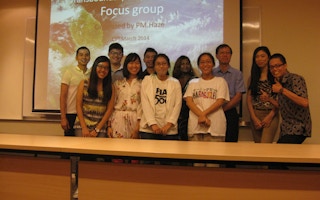Most Singaporeans study the PSI and PM2.5 to find out the extent of the haze and then complain about the Indonesian forest fires.
And then there is Tan Yi Han, 29, founder of the People’s Movement to Stop Haze (PM.Haze).
“My interest in the haze is no different from anyone else in Singapore. I don’t want to breathe polluted air. My dad is almost 70 years old and suffers from breathing difficulties during the haze. And, I am worried about the worsening of the haze in future years,” he said.
Like most Singaporeans, Tan is frustrated by the recurring haze and the blame game that happens every time the haze hits.
The only difference: he is not going to be contented about doing nothing about it.
Tan leads a team of about 10 people from all walks of life – students, researchers, teachers and professionals, who are just as passionate as him about putting an end to the haze.
“
With many forests already cleared, peat swamp forests are being targeted. Peat is accumulation of plant material, and when it becomes dry, it can actually burn like charcoal. When peat burns, the fire is underground, making it very difficult to put out (as I experienced personally). These peat fires can burn for months, covering an area equivalent to hundreds of football fields. Most of the haze pollution actually comes from burning peat
Tan Yi Han, founder of the People’s Movement to Stop Haze
A financial consultant by day, he said his team consists of volunteers and is self-funding.
Since June last year, Tan has been doing his own research on site.
“I went to Malaysia and Indonesia to volunteer with NGOs involved in fighting haze. I fought peat fires and visited burnt sites in Indonesia where the land was scarred all the way to the horizon. I talked to villagers to understand why the fire started and why it got so bad,” he said.
“A significant amount of our consumption and investment dollars goes to palm oil and pulp and paper companies in Indonesia. The more we consume, the more forests have to be cleared to meet the demand.
“With many forests already cleared, peat swamp forests are being targeted. Peat is accumulation of plant material, and when it becomes dry, it can actually burn like charcoal. When peat burns, the fire is underground, making it very difficult to put out (as I experienced personally). These peat fires can burn for months, covering an area equivalent to hundreds of football fields. Most of the haze pollution actually comes from burning peat,” he said.
“Our understanding of haze in Singapore is just the tip of the iceberg. There is a huge story behind the haze and if we want to solve the problem, we must first understand this story,” he added.
Earlier this month, Tan was in Jambi and Riau provinces in Sumatra to meet representatives from eight Indonesian NGOs.
He learnt that there is no one simple solution to a very complex problem.
“Land is cleared by various parties: plantation companies, local small-holders, outside investors and poor migrants,” he said
“The migrants, for instance, do not have official title to the land, but are driven by desperation to clear forests to grow crops for their livelihood,” he added.
His recent trips to Indonesia come in light of government’s warnings of the haze returning, which could persist for as long as three months.
“Despite the Singapore government’s best efforts, it is clear that they can’t do much about the problem other than nag at their counterparts in Indonesia,” he said.
“We should not always rely on our government to fix everything,” he added.
Tan and his team at PM.Haze will be embarking on a Hotspot Investigation Project to Indonesia from June 20 to 26.
“We will be filming a documentary to give people in Singapore a glimpse into the story behind the haze. We are also inviting like-minded people to brainstorm possible solutions to tackle the issue,” he said.
“My main priority this year is to build up our knowledge base and find ways in which ordinary Singaporeans can do to stop the haze. The other priority is to bring together people who share our passion and commitment in order to build a strong core team.
“People are our most important asset. I’m not too worried about money, because once we have a solid team and solid ideas, I’m sure we will attract financial support,” he said.
If you are interested to find out more about what they do, please contact Tan Yi Han at yihan@pmhaze.org
This article originally appeared in The Independent Singapore.










